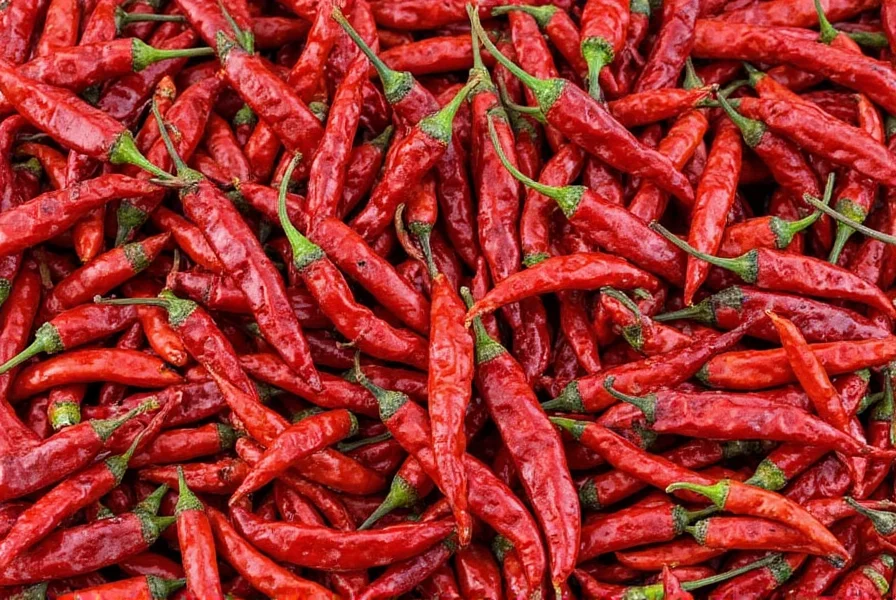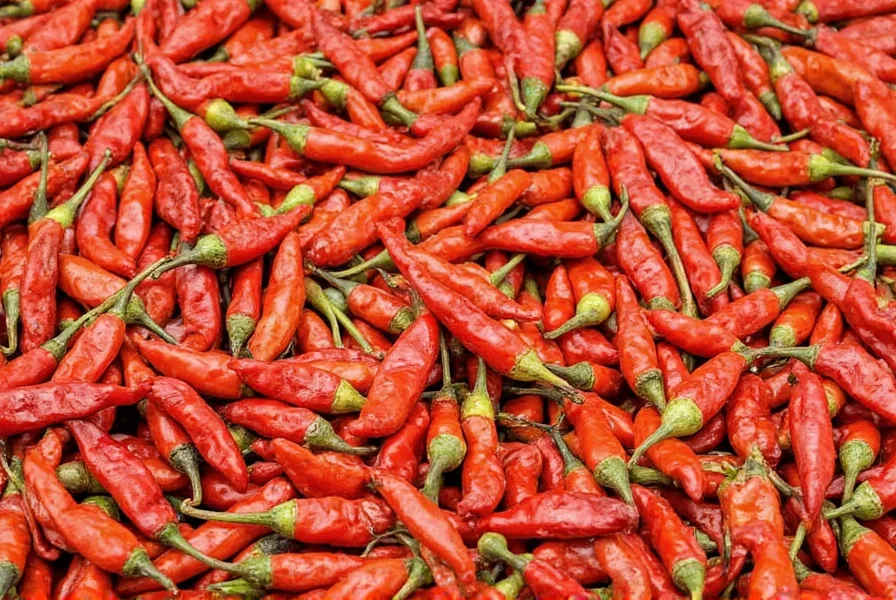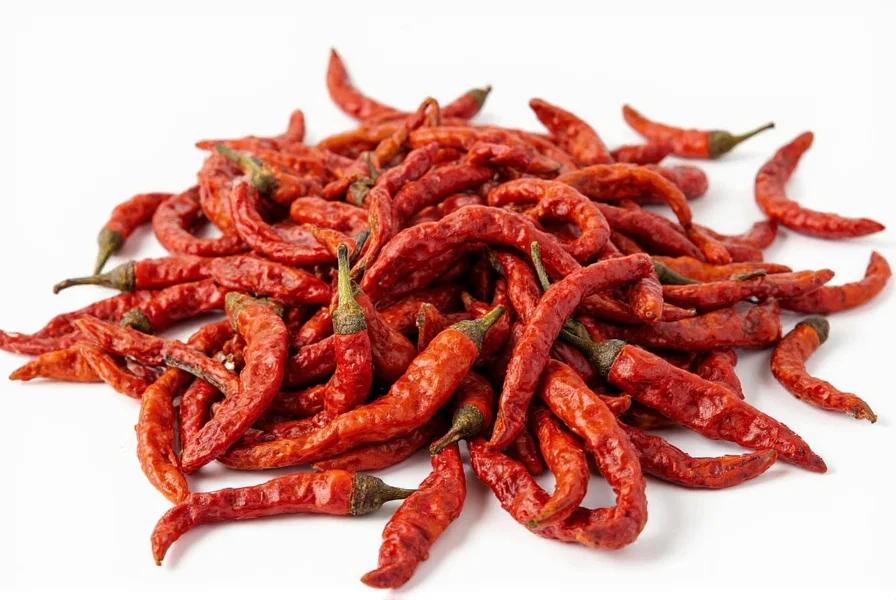Table of Contents
What Is Dried Chile?
Dried chile is a chili pepper that has been dehydrated to intensify its flavor and extend its shelf life. This versatile spice is a staple in global cuisines, offering a wide range of heat levels and flavor profiles from sweet and smoky to fiery and citrusy. Unlike fresh peppers, dried chile concentrates its natural compounds, providing deeper complexity without added moisture. It's essential for authentic dishes like mole, chili con carne, and adobo, and serves as the foundation for many spice blends worldwide.
Dried Chile Types & Heat Levels
Understanding chile varieties is key to selecting the right one for your recipe. Each type has distinct flavor characteristics and Scoville heat units (SHU). Here's a comparison of the most commonly used dried chiles:
| Type | Flavor Profile | Heat Level (Scoville) | Best Use Cases |
|---|---|---|---|
| Chipotle | Smoky, slightly sweet, earthy | 2,500–8,000 | Barbecue sauces, adobo marinades, braised meats |
| Ancho | Mild, raisin-like sweetness, chocolate undertones | 1,000–1,500 | Mole sauces, stews, roasted vegetables |
| Guajillo | Tangy, fruity, with berry notes | 2,500–5,000 | Salsas, soups, marinades for chicken or fish |
| Poblano | Mild, grassy, slightly sweet with pepper aroma | 1,000–1,500 | Chiles rellenos, stuffing, fresh salsas |
| De Arbol | Sharp, citrusy, clean heat | 15,000–30,000 | Hot sauces, pickling, spice rubs for grilled foods |
| Pasilla | Dark, raisin-like, with coffee and tobacco notes | 1,000–2,500 | Mole negro, complex sauces, slow-cooked dishes |
When selecting dried chiles, always consider both heat level and flavor profile. For example, Ancho provides rich depth without overwhelming heat, while De Arbol delivers intense heat with bright citrus notes. Understanding these differences ensures perfect balance in your dishes.
Essential Cooking Techniques
Mastering these techniques unlocks the full potential of dried chile in your cooking:
- Rehydration: For sauces and salsas, soak whole chiles in hot (not boiling) water for 15-20 minutes until pliable. Remove stems and seeds before blending for smoother texture.
- Toasting: Dry-toast chiles in a skillet over medium heat for 30-60 seconds per side until fragrant. This enhances smoky depth without burning. Cool completely before grinding.
- Infusing: Add whole dried chiles to oils, broths, or vinegars for 10-15 minutes to extract flavor. Remove before serving to control heat intensity.
- Grinding: Use a spice grinder for fresh powder. For best results, toast chiles first then grind in small batches. Store in airtight containers to preserve volatile compounds.

For authentic mole sauce, combine Ancho, Pasilla, and Chipotle chiles with toasted spices and dark chocolate. This creates a complex, balanced flavor profile that defines traditional Mexican cuisine. In chili con carne, use Guajillo for fruity notes and De Arbol for heat control.
How to Choose the Best Dried Chile
Selecting high-quality dried chiles requires attention to these key factors:
- Appearance: Look for vibrant, deep colors without dullness or white spots. Avoid chiles that appear cracked or brittle.
- Smell: Fresh chiles should have a strong, pleasant aroma. Musty or stale smells indicate age or improper storage.
- Texture: Good quality chiles are slightly pliable, not rigid or crumbly. They should bend without breaking when handled gently.
Top recommended products for home cooks:
- La Costena Ancho Chile Peppers
- Why it's great: Consistent mild heat with rich sweetness, perfect for beginners
- Best for: Traditional mole sauces, roasted vegetable dishes
- Storage tip: Keep in original sealed bag until use, then transfer to glass jar
- Chili Pepper Co. De Arbol Chile
- Why it's great: Pure, clean heat with citrus notes, no bitterness
- Best for: Hot sauces, spice rubs, pickling brines
- Storage tip: Freeze in airtight container for long-term freshness
- McCormick Gourmet Ground Chipotle Pepper
- Why it's great: Pre-ground convenience with consistent smoky flavor
- Best for: Barbecue rubs, taco seasoning, chili con carne
- Storage tip: Use within 6 months for optimal flavor intensity
Proper Storage Methods
Correct storage preserves flavor potency and prevents spoilage:
- Short-term (up to 6 months): Store in airtight glass jars away from light and heat sources. Keep in a cool, dark pantry.
- Long-term (up to 1 year): Freeze whole chiles in vacuum-sealed bags. Thaw completely before use to avoid moisture buildup.
- Ground chile powder: Store in small airtight containers in the freezer. Powder loses potency faster than whole chiles due to increased surface area exposure.

Always label containers with purchase date and chile type. Check periodically for signs of moisture or mold. Properly stored, dried chiles maintain 80-90% of their original flavor for 6-12 months.
Expert Usage Tips
These professional techniques maximize flavor while controlling heat:
- Heat control: Remove seeds and white membranes (placenta) before using to reduce capsaicin content by up to 70%. This preserves flavor while lowering intensity.
- Flavor balancing: Add acidic ingredients like lime juice or vinegar to counteract excessive heat. Sweet elements like honey or fruit also balance spice effectively.
- Layering technique: Toast whole chiles first, then rehydrate and blend for maximum flavor extraction. This creates deeper complexity than using pre-ground powder alone.
- Substitution guide: For Chipotle, use smoked paprika + cayenne (1:1 ratio). For Guajillo, substitute Ancho with 10% more quantity for similar tanginess.
Frequently Asked Questions
How do I properly rehydrate dried chiles for cooking?
Remove stems and seeds, then place chiles in a bowl of hot (not boiling) water. Submerge completely and soak for 15-20 minutes until pliable. For enhanced flavor, add aromatics like garlic or bay leaves to the water. Press down occasionally to ensure full contact. Drain and pat dry before blending or chopping. Never use chlorinated tap water as it affects flavor.
What's the best way to toast dried chiles without burning them?
Use a dry skillet over medium heat. Place whole chiles in the pan and press gently with a spatula, turning every 15-20 seconds. Toast for 30-60 seconds total until fragrant but not darkened. You'll know they're ready when they release a rich, smoky aroma. Immediately transfer to a cool surface to stop cooking. Burnt chiles develop bitter notes that ruin dishes.
How can I reduce the heat level of dried chiles in my recipes?
Remove seeds and white membranes (placenta) which contain 80% of capsaicin. Soak rehydrated chiles in milk or buttermilk for 10 minutes to neutralize heat. Add acidic ingredients like lime juice or tomatoes during cooking to counteract spiciness. Always start with less than you think you need - you can add more heat later but can't remove it once incorporated.
What's the difference between using whole dried chiles versus chile powder?
Whole dried chiles offer superior flavor control through toasting and rehydration. They provide fresher, more complex notes with better texture for sauces. Chile powder is convenient but loses volatile compounds during processing, resulting in less nuanced flavor. For maximum impact, toast whole chiles and grind them fresh as needed. Powder works best for quick rubs where texture isn't critical.
How do I know if my dried chiles have gone bad or lost potency?
Check for mold, off smells (rancid or musty), or extreme brittleness. Fresh dried chiles should be pliable, deeply colored, and release a strong fragrance when toasted. If they no longer make your nose tingle slightly or lack vibrant color, they've lost potency. For ground powder, loss of aroma and clumping indicate spoilage. Replace chiles that show any of these signs for best results.
Can I substitute one type of dried chile for another in recipes?
Yes, but with careful consideration. Ancho and Pasilla often substitute for each other in mole recipes. Chipotle works for smoked paprika but is hotter (use half the amount). For heat control, use 1/4 the amount of De Arbol when substituting for Guajillo. Always taste as you go - start with smaller quantities and adjust. When unsure, blend multiple types to approximate the intended flavor profile.
What are the health benefits of using dried chiles in cooking?
Dried chiles contain capsaicin, which may boost metabolism and provide pain relief. They're rich in vitamin A (from carotenoids), vitamin C, and antioxidants that support immune function. Capsaicin also has anti-inflammatory properties and may aid digestion. The drying process concentrates these beneficial compounds compared to fresh peppers. When used in moderation as part of a balanced diet, dried chiles contribute to heart health and weight management.
Final Thoughts
Dried chile is far more than just a source of heat - it's a flavor powerhouse that adds depth, complexity, and authenticity to global cuisines. By understanding the unique characteristics of different varieties, mastering proper techniques, and storing them correctly, you can transform simple dishes into extraordinary culinary experiences.
Whether you're making traditional mole sauce or experimenting with new recipes, dried chile offers endless possibilities. Start with small quantities, taste as you go, and let its nuanced flavors elevate your cooking to new heights.












 浙公网安备
33010002000092号
浙公网安备
33010002000092号 浙B2-20120091-4
浙B2-20120091-4